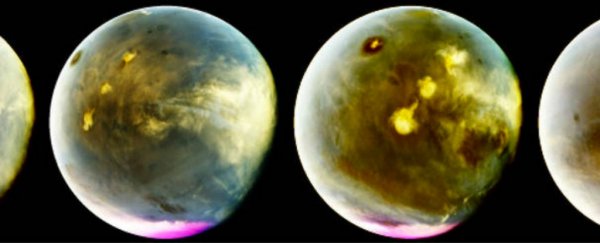NASA has just released new ultraviolet photos of Mars taken from the Mars Atmosphere and Volatile Evolution (MAVEN) spacecraft, and they showcase the Red Planet's unique atmosphere, cloud formations, and 'nightglow'.
The new photos are the first of their kind, providing researchers with highly detailed images that weren't possible until now.
"MAVEN obtained hundreds of such images in recent months, giving some of the best high-resolution ultraviolet coverage of Mars ever obtained," said one of the researchers, Nick Schneider from the University of Colorado, Boulder.
One of the most interesting new photos is that of Mars' nitric oxide (NO) 'nightglow' emission.
Nightglow is when a planet's dark side still emits light even though there's no outside light shining on it, thanks to chemical reactions happening in the atmosphere on its other side.
 NASA/MAVEN/University of Colorado
NASA/MAVEN/University of Colorado
"Mars' night side atmosphere emits light in the ultraviolet due to chemical reactions that start on Mars' dayside," the team explains.
"Ultraviolet light from the Sun breaks down molecules of carbon dioxide and nitrogen, and the resulting atoms are carried around the planet by high-altitude wind patterns that encircle the planet."
When the winds from the dayside drop, these atoms descend closer to the surface, and nitrogen and oxygen smash together, forming nitric oxide and releasing energy that the team can see in ultraviolet light.
While NASA scientists have hypothesised that Mars would create a nightglow, this is the first time they've gotten photographic evidence of it.
In the daylight photos, the team says they were able to see how the Martian atmosphere changes with the seasons. Specifically, they were able to witness the Red Planet's south pole as spring sets in, offering them a unique look at how the planet's ozone forms and fades.
The false colour image below highlights the ozone concentration around the south pole in pink:
 NASA/MAVEN/University of Colorado
NASA/MAVEN/University of Colorado
"Ozone is destroyed when water vapour is present, so ozone accumulates in the winter polar region where the water vapour has frozen out of the atmosphere," the team said.
"The images show ozone lasting into spring, indicating that global winds are inhibiting the spread of water vapour from the rest of the planet into winter polar regions."
MAVEN was also able to witness how clouds form around gigantic Martian volcanoes. With these new images, the team says they will be able to understand more about how water vapour and other seasonal activities take place there.
In the false colour images below, you can see the light colours - clouds - swirling around the dark spot towards the top of the planet, which is actually Olympus Mons - Mars' tallest volcano.
 NASA/MAVEN/University of Colorado
NASA/MAVEN/University of Colorado
All of these images were made possible by the fact that MAVEN can take global pictures – an image of the entire planet – in ultraviolet on a regular basis, allowing scientists to observe changes better than ever before.
"MAVEN's elliptical orbit is just right," said team member Justin Deighan, also from the University of Colorado, Boulder. "It rises high enough to take a global picture, but still orbits fast enough to get multiple views as Mars rotates over the course of a day."
Check out the video below to see Martian cloud formation from MAVEN's perspective:
